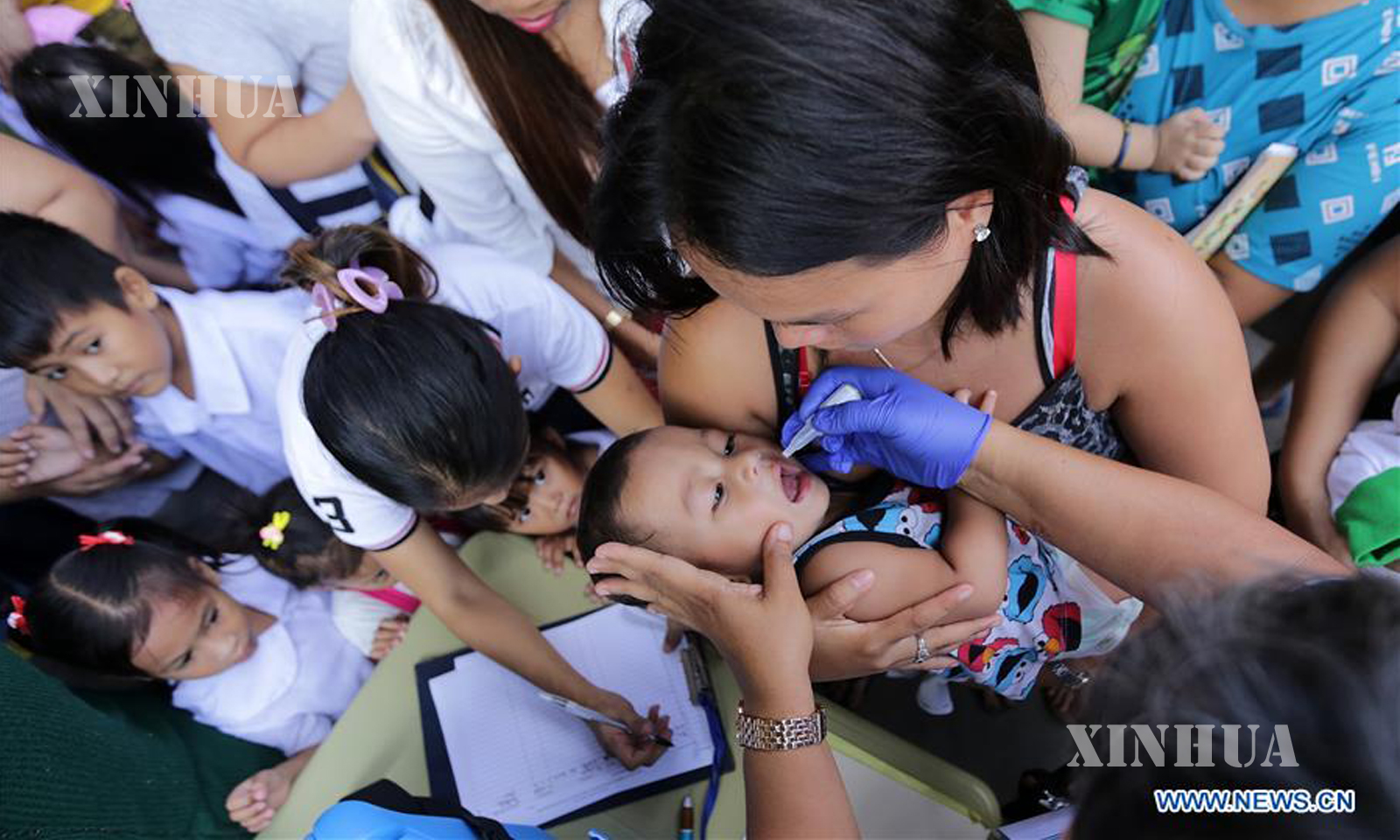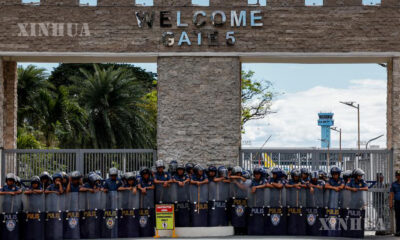Asia
ဖိလစ်ပိုင်နိုင်ငံတွင် ပိုလီယိုရောဂါဖြစ်ပွားမှု နိဂုံးချုပ်ပြီဖြစ်ကြောင်း WHO နှင့် UNICEF ကြေညာ

မနီလာ၊ ဇွန် ၁၁ ရက် (ဆင်ဟွာ)
ဖိလစ်ပိုင်နိုင်ငံတွင် ပိုလီယိုရောဂါကူးစက်မှုပြန်လည်မြင့်တက်လာပြီးနောက် နှစ်နှစ်နီးပါးမျှအကြာတွင် ရောဂါဖြစ်ပွားမှု အဆုံးသတ်နိုင်ခဲ့သည့်အတွက် ဂုဏ်ပြုကြောင်း ကမ္ဘာ့ကျန်းမာရေးအဖွဲ့ (WHO) နှင့် ကုလသမဂ္ဂ ကလေးများရန်ပုံငွေအဖွဲ့(UNICEF) တို့က ဇွန် ၁၁ ရက်၌ ကြေညာခဲ့သည်။
ဖိလစ်ပိုင်နိုင်ငံ ကျန်းမာရေးဦးစီးဌာန (DOH) အနေဖြင့် ယခုနှစ် ဇွန် ၃ ရက်တွင် ပိုလီယိုရောဂါဖြစ်ပွားမှု တုံ့ပြန်ရေးကို တရားဝင်ရပ်တန့်လိုက်ပြီဖြစ်ကြောင်း ပူးတွဲထုတ်ပြန်ချက်၌ ကုလသမဂ္ဂအေဂျင်စီများက ပြောကြားခဲ့သည်။
“လွန်ခဲ့တဲ့ ၁၆ လအတွင်း ကလေးငယ်တစ်ဦးတစ်ယောက် သို့မဟုတ် ပတ်ဝန်းကျင်မှာ ဗိုင်းရပ်စ်ကူးစက်မှု မတွေ့ရှိတော့တဲ့အတွက် ဒီဆုံးဖြတ်ချက်က ထွက်ပေါ်လာခြင်းဖြစ်ပါတယ်” ဟု ထုတ်ပြန်ချက်က ဖော်ပြထားသည်။
ဖိလစ်ပိုင်နိုင်ငံရှိ ရောဂါဖြစ်ပွားရာဒေသတွေမှာ ကာကွယ်ဆေးထိုးနှံမှု ပြင်းပြင်းထန်ထန်ဆောင်ရွက်ခြင်းနှင့် စောင့်ကြည့်ရေးလုပ်ငန်းများ အပါအဝင် ဘက်စုံရောဂါတုံ့ပြန်ရေးဆောင်ရွက်ချက်များက ပိုလီယိုဗိုင်းရပ်စ်ပျံ့နှံ့မှုကို တားဆီးနိုင်ခဲ့ခြင်းဖြစ်ကြောင်း အေဂျင်စီများက ပြောခဲ့သည်။
ဖိလစ်ပိုင်နိုင်ငံတွင် ၁၉ နှစ်ကြာ ပိုလီယိုကင်းစင်ပြီးနောက် ပိုလီယိုရောဂါဖြစ်ပွားမှုကို ၂၀၁၉ ခုနှစ် စက်တင်ဘာ ၁၉ ရက်တွင် DOH က ကြေညာခဲ့သည်။
ယင်းနောက် ဖိလစ်ပိုင်နိုင်ငံ အစိုးရသည် WHO ၊ UNICEF နှင့် အခြားသောမိတ်ဖက်များနှင့်အတူ ဗိုင်းရပ်စ်ပျံ့နှံ့မှု တားဆီးရန် နိုင်ငံတစ်ဝန်း ပိုလီယိုကမ်ပိန်းများ လုပ်ဆောင်ခဲ့သည်။
COVID-19 ၏ တစ်ပြိုင်နက် သက်ရောက်မှုကြောင့် ကာကွယ်ဆေးထိုးနှံခြင်းအပေါ် ကြီးမားသော စိန်ခေါ်မှုများ ရှိနေသည့်ကြားမှ DOH အနေဖြင့် ပိုလီယိုကာကွယ်ဆေးထိုးနှံခြင်း ကမ်ပိန်းများကိုလည်း အားသွန်ခွန်စိုက် ဆက်လက်လုပ်ဆောင်ခဲ့ကြောင်း သိရသည်။
အထူးသဖြင့် DOH က ရောဂါကာကွယ်ရေးနှင့် ထိန်းချုပ်ရေး၌ ကျန်းမာရေးဝန်ထမ်းများအား သင်တန်းပေးခြင်းနှင့် စုစည်းတာဝန်ချထားပေးခြင်းတို့အား တိုးမြှင့်ဆောင်ရွက်ခြင်း၊ ကလေးငယ်များအား နေအိမ်များနှင့် သတ်မှတ်ထားသော ကျန်းမာရေးစင်တာများ၌ ကာကွယ်ဆေးထိုးနှံပေးနိုင်ရန် ကျန်းမာရေးဝန်ထမ်းများအတွက် တစ်ကိုယ်ရေ အကာအကွယ်ပစ္စည်း ထောက်ပံ့ပေးခြင်းတို့အတွက် UNICEF နှင့် WHO တို့က ချီးကျူးခဲ့ကြောင်း သိရသည်။
ထို့ပြင် WHO အနေဖြင့် ပိုလီယိုရောဂါ စောင့်ကြည့်ခြင်း၊ စီမံကိန်းရေးဆွဲခြင်း၊ ကာကွယ်ဆေးထိုးနှံခြင်း ကမ်ပိန်းများအတွက် ပြင်ဆင်ခြင်းနှင့် စောင့်ကြည့်ခြင်း၊ ရောဂါကာကွယ်ရေးနှင့် ထိန်းချုပ်ရေး ဆောင်ရွက်ချက်များနှင့် အန္တရာယ်ရှိသောဆက်သွယ်ရေးများအတွက် နည်းပညာနှင့် လုပ်ငန်းလည်ပတ်မှုများ ပံ့ပိုးပေးခြင်းဖြင့် ဖိလစ်ပိုင်နိုင်ငံ၏ ပိုလီယိုရောဂါဖြစ်ပွားမှု တုံ့ပြန်ခြင်းကို ပံ့ပိုးပေးခဲ့ကြောင်းသိရသည်။ ထို့ပြင် မြေပြင် နည်းပညာပံ့ပိုးမှုပေးရန် နိုင်ငံတကာနှင့် အမျိုးသားအဆင့် ပိုလီယိုရောဂါ ကျွမ်းကျင်ပညာရှင်များကိုလည်း ရောဂါဖြစ်ပွားသော ဒေသများနှင့် ဒေသတွင်း အကောင်အထည်ဖော်နေသူများထံ စေလွှတ်ခဲ့သည်။
“ဒါက ပြည်သူ့ကျန်းမာရေးအတွက် အဓိကအောင်နိုင်မှုတစ်ခုဖြစ်ပြီး COVID-19 ကပ်ရောဂါဖြစ်ပွားနေတဲ့ကြားက စုပေါင်းကြိုးပမ်းအားထုတ်မှုတွေက ဘာတွေဆောင်ရွက်နိုင်သလဲဆိုတဲ့ ဥပမာကောင်းတစ်ခုလည်း ဖြစ်ပါတယ်” ဟု ဖိလစ်ပိုင်နိုင်ငံဆိုင်ရာ WHO ကိုယ်စားလှယ် Rabindra Abeyasinghe က ပြောခဲ့သည်။
ထို့ပြင် UNICEF ကလည်း ကာကွယ်ဆေး ရရှိရန်ဆောင်ရွက်ခြင်းနှင့် ပို့ဆောင်ပေးခြင်း၊ ကာကွယ်ဆေးထိုးနှံမှုလမ်းညွှန်ချက်များ ဖော်ဆောင်ခြင်း၊ လူမှုရေးစည်းရုံးလှုံ့ဆော်မှု၊ ရပ်ရွာအဖွဲ့ဝင်များနှင့် ထင်ပေါ်ကျော်ကြားသူများအား စေ့စပ်ညှိနှိုင်းပေးခြင်းနှင့် DOH နှင့် နိုင်ငံတစ်ဝန်းရှိ ဒေသခံအစိုးရအဖွဲ့များအား ကလေးငယ်များအားလုံး ကာကွယ်ဆေးထိုးနှံနိုင်စေရန် စွမ်းရည်မြှင့်တင်ပေးခြင်း စသည်တို့မှတစ်ဆင့် DOH အား ပံ့ပိုးပေးခဲ့ကြောင်း သိရသည်။
“ဖိလစ်ပိုင်နိုင်ငံမှာ ပိုလီယိုကာကွယ်ဆေးထိုးနှံမှု အောင်မြင်ခြင်းက ကလေးငယ်များအတွက် ကျွန်မတို့ အတူတကွလုပ်ဆောင်တဲ့အခါမှာ ကြီးမားတဲ့အရာတွေဖြစ်လာတယ်ဆိုတာရဲ့ သက်သေပါပဲ” ဟု ဖိလစ်ပိုင်နိုင်ငံဆိုင်ရာ UNICEF ကိုယ်စားလှယ် Oyunsaikhan Dendevnorov က ပြောခဲ့သည်။
ပိုလီယိုရောဂါသည် ကူးစက်မှုမြင့်မားသော၊ မသန်စွမ်းဖြစ်စေနိုင်သော၊ တစ်ခါတစ်ရံ အသက်ပင်သေဆုံးစေနိုင်သော ရောဂါဖြစ်ပြီး ကာကွယ်ဆေးထိုးနှံခြင်းဖြင့် ရောဂါမဖြစ်ပွားအောင် ရှောင်ရှားနိုင်သည်။ အသက် ၅ နှစ်အောက် ကလေးများမှာ အဓိကအားဖြင့် ရောဂါကူးစက်လွယ်လေ့ရှိသည်။
ယခုအခါ အဆိုပါ ရောဂါသည် အာဖဂန်နစ္စတန်နှင့် ပါကစ္စတန်နိုင်ငံ နှစ်နိုင်ငံတွင်သာ ကူးစက်ရောဂါအဖြစ် ဆက်လက်ကျန်ရှိနေကြောင်းနှင့် ပိုလီယိုရောဂါသည် ယင်းနိုင်ငံများတွင် ရောဂါအမြစ်ဖြတ်နိုင်ချိန်တွင် အပြည့်အဝနှိမ်နင်းနိုင်သည့် ဒုတိယမြောက်ရောဂါဖြစ်မည်ဖြစ်သည်။ (Xinhua)
———————————–
(English Version)
WHO, UNICEF declare end of polio outbreak in Philippines
2021-06-11 15:58:55
MANILA, June 11 (Xinhua) — The World Health Organization (WHO) and the United Nations Children’s Fund (UNICEF) hailed the Philippines on Friday for ending the polio outbreak almost two years after the highly infectious disease re-emerged in the Southeast Asian country.
In a joint statement, the UN agencies said the Philippines’ Department of Health (DOH) officially stopped the polio outbreak response on June 3 this year.
“The decision came as the virus has not been detected in a child or the environment in the past 16 months,” the statement read.
The agencies said comprehensive outbreak response actions, including intensified immunization and surveillance activities in affected areas of the Southeast Asian country, curbed the spread of the poliovirus.
The DOH announced a polio outbreak in the Philippines on Sept. 19, 2019, after 19 years of a polio-free status.
Since then, the Philippine government and the WHO, the UNICEF, and other partners mounted nationwide polio campaigns to stop the spread of the virus.
Despite the tremendous challenges to immunization presented by the simultaneous impact of COVID-19, the DOH had continued robust polio immunization campaigns.
In particular, the UNICEF and the WHO lauded the DOH for enhancing training and mobilizing health workers in infection prevention and control, and supplying them with personal protective equipment to enable vaccinating children in their homes and designated health centers.
The WHO supported the country’s polio outbreak response by providing technical and operations support on intensifying polio surveillance, planning, preparing for and monitoring immunization campaigns, infection prevention and control measures, and risk communication. It also deployed international and national polio experts who provided on-the-ground technical support to the affected regions and local implementers.
“This is a major win for public health and is an excellent example of what collective efforts can attain, even in the midst of the COVID-19 pandemic,” Rabindra Abeyasinghe, WHO representative to the Philippines, said.
The UNICEF supported the DOH through vaccine procurement and delivery, development of immunization guidelines, social mobilization, engaging community members and influencers, and building the capacity of DOH and local government units nationwide to plan and ensure that all children are inoculated.
“The success of the polio immunization in the Philippines is proof that when we come together for children, great things happen,” UNICEF Representative to the Philippines Oyunsaikhan Dendevnorov said.
Polio is a highly infectious, crippling, and sometimes fatal disease that can be avoided with a vaccine. Children under the age of five are particularly vulnerable.
The WHO said the disease remains endemic now in the only two countries of Afghanistan and Pakistan, and polio will be the second disease ever to be completely eradicated when eradicated there. Enditem
A baby receives an oral poliovirus vaccine during an anti-polio campaign by the Philippine Department of Health in Manila, the Philippines, Aug. 19, 2019. (Xinhua/Rouelle Umali)






